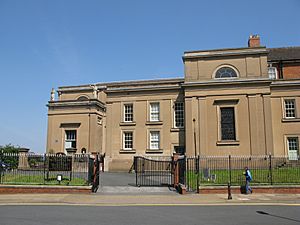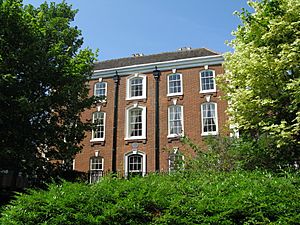St Peter and St Paul's Church, Wolverhampton facts for kids
Quick facts for kids St Peter and St Paul Church |
|
|---|---|
 |
|
| 52°35′16″N 2°07′50″W / 52.5877°N 2.1305°W | |
| OS grid reference | SO9125798890 |
| Location | Wolverhampton, West Midlands |
| Country | United Kingdom |
| Denomination | Roman Catholic |
| Website | rcwlvwest.com |
| History | |
| Status | Parish church |
| Dedication | Saints Peter and Paul |
| Architecture | |
| Functional status | Active |
| Heritage designation | Grade II* listed |
| Designated | 16 July 1949 |
| Architect(s) | Joseph Ireland and Edward Goldie |
| Style | Greek Revival |
| Years built | 1826–1828 |
| Specifications | |
| Number of domes | 3 |
| Administration | |
| Deanery | Dudley and Wolverhampton |
| Archdiocese | Birmingham |
| Province | Birmingham |
The St Peter and St Paul Church is a Roman Catholic church located in Wolverhampton, West Midlands, England. It was built between 1826 and 1828. Later additions were made in 1901 and 1928. The original design was by Joseph Ireland. The 1901 extension was designed by Edward Goldie. This church is part of Giffard House, which now serves as a home for the church's priests. Both the church and Giffard House are very important buildings. They are listed as Grade II* historic buildings.
Contents
A Look Back: The Church's Story
Giffard House and Catholics in Wolverhampton
The Giffard family were Catholics who kept their faith even when it was difficult. They used their home, Giffard House, to help priests and other Catholics. After the Gunpowder Plot in 1605, two Catholics were executed in Wolverhampton. The church still has a special cup, called a Chalice, from the English Civil War. It is still used during church services.
In 1678, during the reign of King Charles II, Catholics faced hard times. Two Jesuit priests were arrested in Wolverhampton. One was executed, and another died in prison. Peter Giffard, a member of the family, was also arrested but survived. Later, in 1688, when King James II left the country, there were more troubles. The chapel in Giffard House was attacked.
In the 17th century, many Roman Catholics lived in Wolverhampton. The town was even called "Little Rome" by some. Important local families like the Giffards, Levesons, and Whitgreaves remained Catholic. Bishop Bonaventure Giffard, a leader of the Catholic Church in London, was related to the Giffards. The Giffards of Chillington Hall were very involved with St Peter and St Paul's Church.
In the early 1700s, a new Giffard House was built. The current house was constructed from 1727 to 1729. It was designed by Francis Smith of Warwick. From 1804 to 1826, it was the home of Bishop John Milner. He was an important Catholic leader. Bishop Milner was buried at the house. He also left money to help build the church.
Building the Church
St Peter and St Paul's Church is one of the oldest Roman Catholic church buildings in England. It was built during and after the English Reformation. At first, the chapel in Giffard House was only for the Giffard family. But later, it opened to other Catholic worshippers.
The church you see today was built in several steps.
Early Chapel Extensions (1743–1765)
The first chapel was a room at the back of Giffard House. This chapel was made bigger in 1743. It was decorated in 1765. Bishop Milner lived in Giffard House until he died in 1826. His memorial, designed by Pugin, is inside the church. The Bishop's grave is in the crypt below the church.
Joseph Ireland's Design (1826–1828)
In 1826, the chapel was extended again. This time, Joseph Ireland designed it in the Greek Revival style. In 1828, the main part of the church, called the nave, was finished. The church officially opened with a special service. About 60 priests attended the opening.
The side chapels, dedicated to Our Lady and the Sacred Heart, were not yet built. The church was hard to find because it was hidden by other buildings. It was also very secure. A letter from 1831 described it as almost impossible to break into.
Side Chapels Added Later
Two side chapels were built as extensions from the main part of the church.
Sacred Heart Chapel
The Sacred Heart Chapel was designed by Edward Goldie in 1901. He also designed the Sacristy wing, where priests prepare for services.
Lady Chapel
In 1928, the Lady Chapel was built. It was designed by Sandy and Norris.
Saving the Church: A Close Call (1962–1982)
Redevelopment Plans in Wolverhampton (1962)
In 1962, the church faced a big threat. The local council wanted to knock it down. They planned to build a new Civic Centre on the church's site. Father Kavanagh, the priest at the time, formed a group to save the church. This group included both Catholics and non-Catholics. Their efforts worked, and the plan to demolish the church was stopped.
Ring Road Challenges (1967–1982)
In 1967, a new road, the Ring Road, was being built. It was planned to go right through where the church stood. Many nearby buildings were demolished. The church was told its graveyard was safe. However, 42 bodies had to be moved to build a new wall. Then, it was discovered that the church roof had dry rot.
In 1967, the local newspaper, the Express & Star, reported that the house itself was not affected. But the Archdiocese wanted to demolish the church. They thought repairs were too expensive. They also worried that fewer people would come to the church because of the new road. A new church was planned elsewhere. However, the Wolverhampton Council and a new Church Committee worked together. In 1982, the plan to demolish the church was rejected by the government.
Grants were given by the Council and English Heritage to help with repairs. Many people helped raise money. This included Anthony Nicholls, a librarian from Birmingham University. Peter Giffard of Chillington Hall, whose family had been involved for centuries, also helped.
Modern Updates (2006)
By 2006, the church needed a full update. It received a lot of money from the will of the Armstrong brothers. Father Patrick Daly led a committee to manage the project. Work began, and the church was refurbished.
Parish Life
The church currently holds one Sunday Mass at 10:15 am.
Giffard House is also home to the University of Wolverhampton's Catholic Chaplaincy. The Catholic Society meets there every Tuesday during term time.
See also
- Roman Catholic Archdiocese of Birmingham


